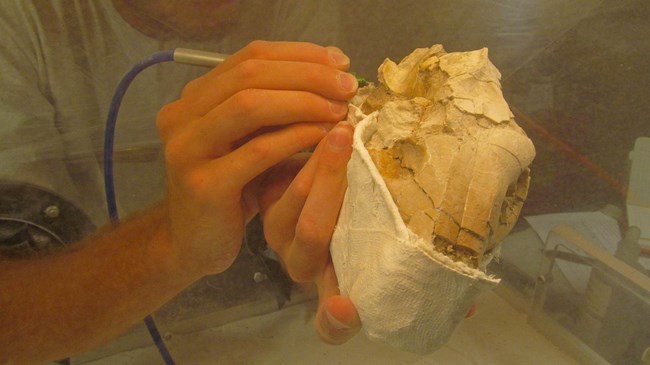Last updated: November 10, 2020
Article
Fossil Lab: Curation & Preservation

NPS Photo

NPS Photo
So... what happens to Badlands fossils after they have been found, brought to the lab, and prepared by paleontologists? After a fossil’s preparation has been completed, park staff will make a cradle for it. A cradle consists of a box, a foam insert with spaces carved out for the fossil, and protective tissue or tyvek lining for the fossil to rest in. Depending on the size of the fossil they may instead get a plaster storage jacket (if very large) or be secured in a small vial or plastic box (if very small).
Once a fossil is safely in its housing, museum staff assigns a catalog number to the fossil so that it can be easily found in the collections. Fossils in the Badlands National Park museum collection are stored taxonomically. That is, based on the fossil’s identification as it relates to the Tree of Life. Other museum collections may house specimens by site location or age. Caring for fossils in the collection relies primarily on what is called preventative maintenance. This includes environmental monitoring for temperature, humidity and pests. Other methods of preventative maintenance includes rehousing specimens. Some of the fossils have been in the collection since the 1960s and either due to time, new techniques or a combination of both, previous storage methods no longer meet housing standards. Museum staff watch for signs of aging in the material –discoloration, deterioration and loss of structural integrity. When this happens, the museum staff may replace some materials, or send it back to the lab for more intensive rehousing.
Preserving fossils is an important part of what park staff do. Fossils not only help paleontologists conduct research – they also give park visitors a glimpse into the past worlds of Badlands National Park. Sometimes fossils will go on loan to other museums and universities for either storage or research. Badlands’ fossils contribute to research in the park, nation and around the world and can be found in museum and university collections worldwide. Fossils are used by researchers in a variety of ways: to better understand environmental shifts in the past, compare evolutionary changes in species, and help identify other fossils as yet unidentified in collections. At the park we use fossils in ranger programs, as comparisons to identify newly excavated fossils still being prepared as well as exhibit displays in the lab.
